Assignment on Mechanical Principles: Fluid Systems and Energy Transfer
VerifiedAdded on 2022/09/15
|10
|1405
|43
Homework Assignment
AI Summary
This assignment explores the principles of fluid systems and energy transfer within the context of mechanical engineering. It begins with calculations of thrust on a submerged surface, considering pressure distribution. The assignment then delves into the application of gas laws, calculating the temperature and mass of air in a tank under varying pressure conditions. Further analysis involves applying Boyle's law to determine pressure changes in a piston with constant temperature. Finally, the assignment describes two methods for measuring the density of solid materials: the buoyancy method and the fluid displacement method, including discussions of accuracy and potential errors. The assignment also outlines the pycnometer method for determining fluid density, detailing the procedure and relevant calculations, along with error analysis. References for the assignment are also included.
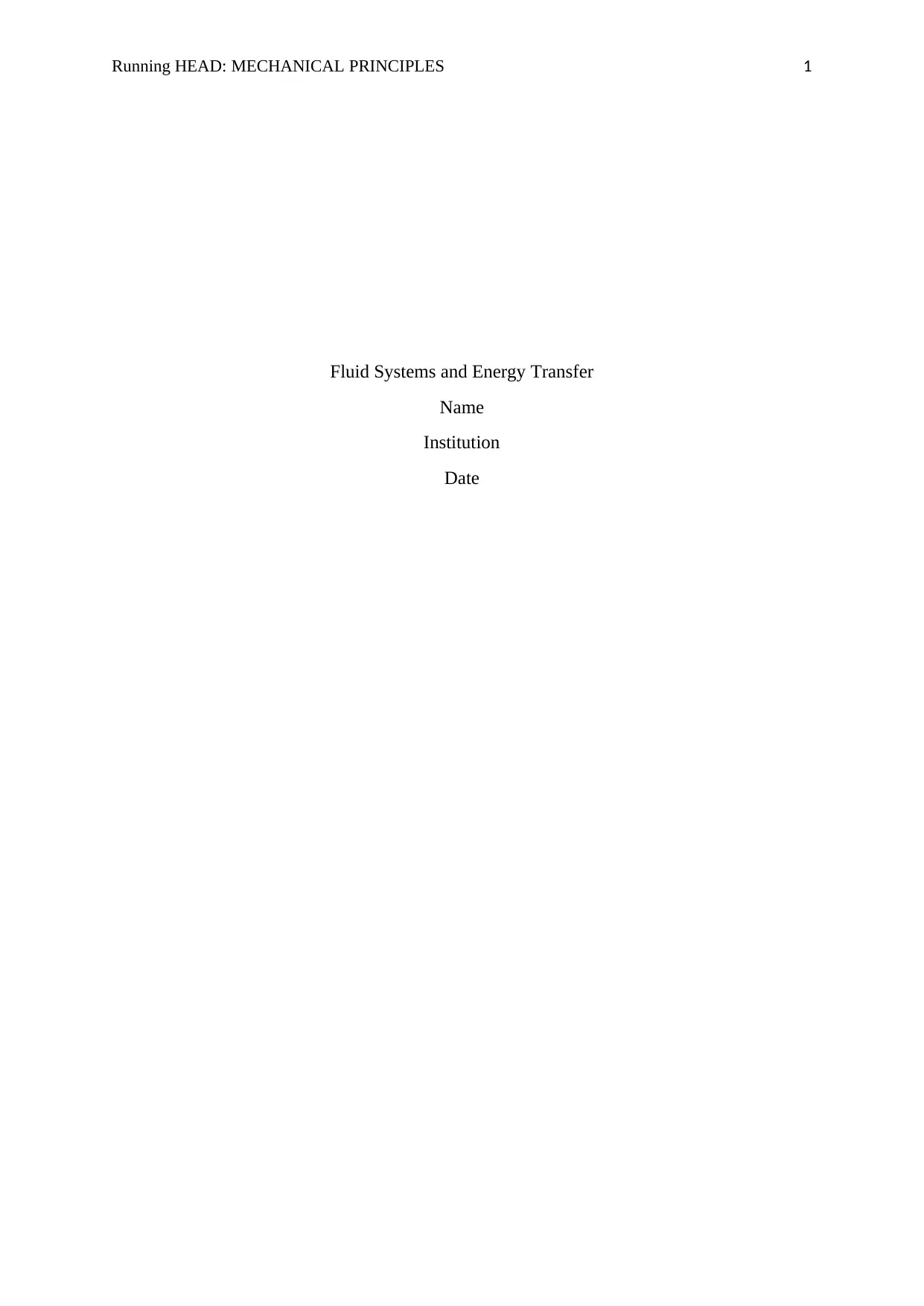
Running HEAD: MECHANICAL PRINCIPLES 1
Fluid Systems and Energy Transfer
Name
Institution
Date
Fluid Systems and Energy Transfer
Name
Institution
Date
Paraphrase This Document
Need a fresh take? Get an instant paraphrase of this document with our AI Paraphraser
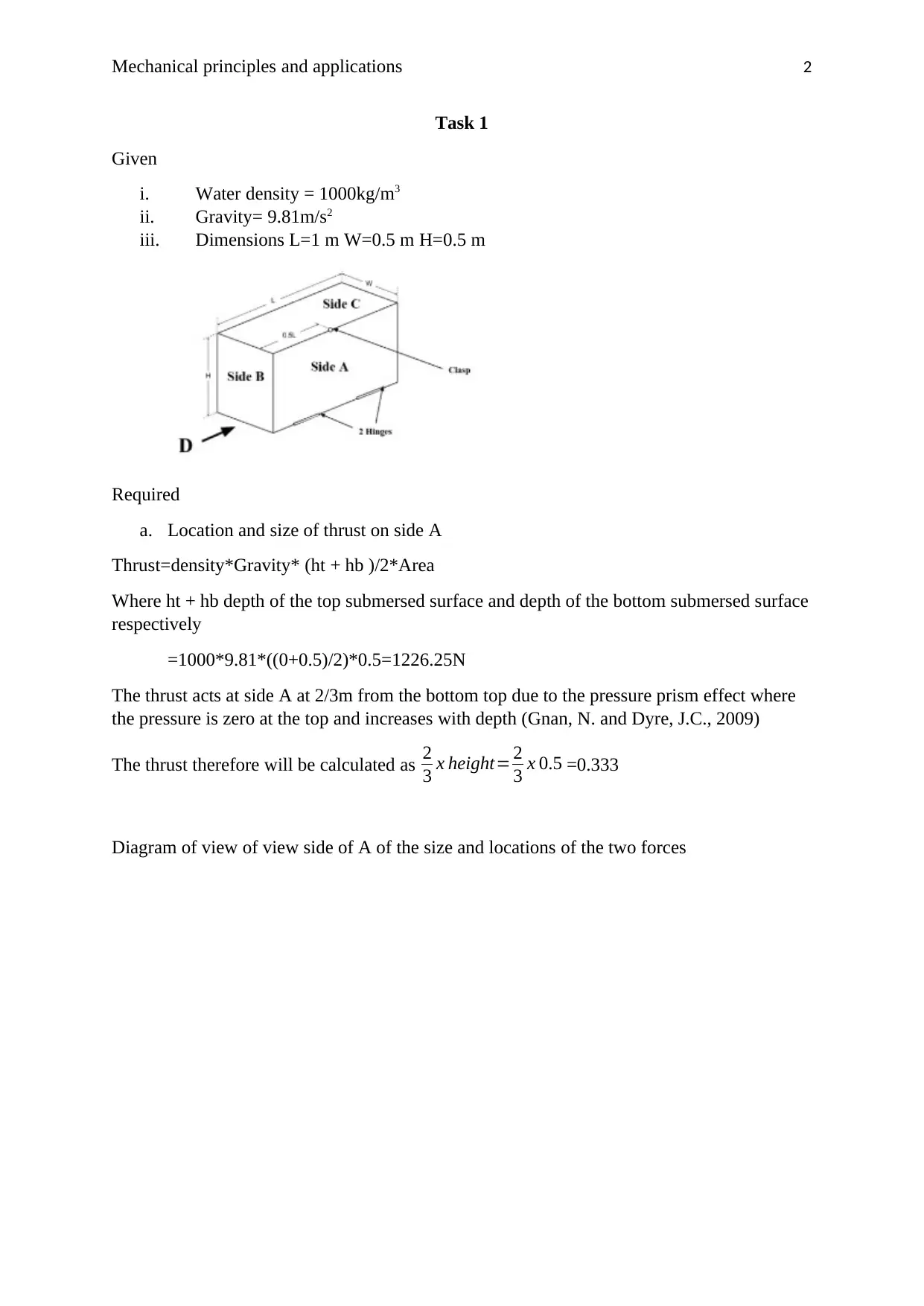
Mechanical principles and applications 2
Task 1
Given
i. Water density = 1000kg/m3
ii. Gravity= 9.81m/s2
iii. Dimensions L=1 m W=0.5 m H=0.5 m
Required
a. Location and size of thrust on side A
Thrust=density*Gravity* (ht + hb )/2*Area
Where ht + hb depth of the top submersed surface and depth of the bottom submersed surface
respectively
=1000*9.81*((0+0.5)/2)*0.5=1226.25N
The thrust acts at side A at 2/3m from the bottom top due to the pressure prism effect where
the pressure is zero at the top and increases with depth (Gnan, N. and Dyre, J.C., 2009)
The thrust therefore will be calculated as 2
3 x height= 2
3 x 0.5 =0.333
Diagram of view of view side of A of the size and locations of the two forces
Task 1
Given
i. Water density = 1000kg/m3
ii. Gravity= 9.81m/s2
iii. Dimensions L=1 m W=0.5 m H=0.5 m
Required
a. Location and size of thrust on side A
Thrust=density*Gravity* (ht + hb )/2*Area
Where ht + hb depth of the top submersed surface and depth of the bottom submersed surface
respectively
=1000*9.81*((0+0.5)/2)*0.5=1226.25N
The thrust acts at side A at 2/3m from the bottom top due to the pressure prism effect where
the pressure is zero at the top and increases with depth (Gnan, N. and Dyre, J.C., 2009)
The thrust therefore will be calculated as 2
3 x height= 2
3 x 0.5 =0.333
Diagram of view of view side of A of the size and locations of the two forces
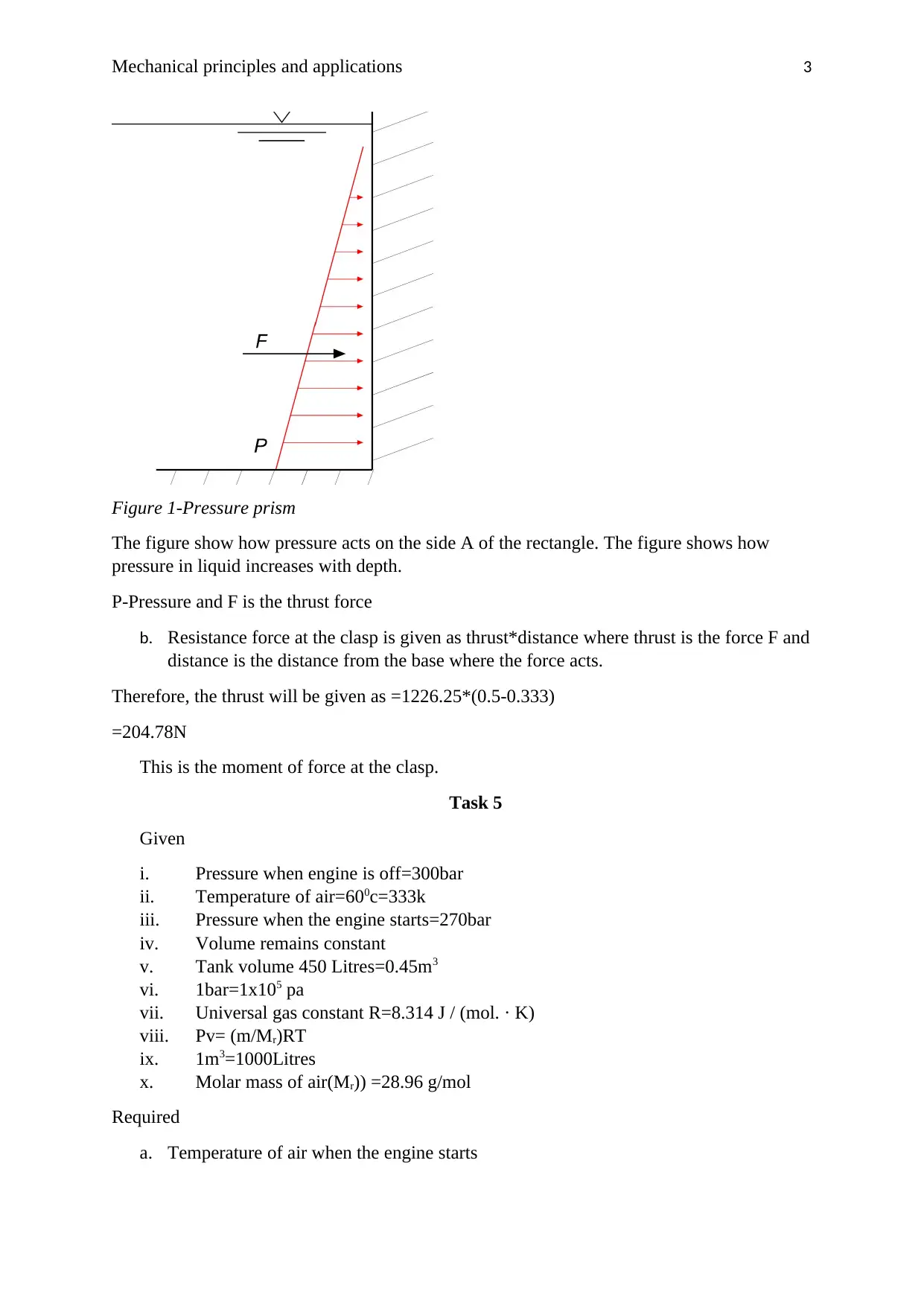
Mechanical principles and applications 3
Figure 1-Pressure prism
The figure show how pressure acts on the side A of the rectangle. The figure shows how
pressure in liquid increases with depth.
P-Pressure and F is the thrust force
b. Resistance force at the clasp is given as thrust*distance where thrust is the force F and
distance is the distance from the base where the force acts.
Therefore, the thrust will be given as =1226.25*(0.5-0.333)
=204.78N
This is the moment of force at the clasp.
Task 5
Given
i. Pressure when engine is off=300bar
ii. Temperature of air=600c=333k
iii. Pressure when the engine starts=270bar
iv. Volume remains constant
v. Tank volume 450 Litres=0.45m3
vi. 1bar=1x105 pa
vii. Universal gas constant R=8.314 J / (mol. · K)
viii. Pv= (m/Mr)RT
ix. 1m3=1000Litres
x. Molar mass of air(Mr)) =28.96 g/mol
Required
a. Temperature of air when the engine starts
Figure 1-Pressure prism
The figure show how pressure acts on the side A of the rectangle. The figure shows how
pressure in liquid increases with depth.
P-Pressure and F is the thrust force
b. Resistance force at the clasp is given as thrust*distance where thrust is the force F and
distance is the distance from the base where the force acts.
Therefore, the thrust will be given as =1226.25*(0.5-0.333)
=204.78N
This is the moment of force at the clasp.
Task 5
Given
i. Pressure when engine is off=300bar
ii. Temperature of air=600c=333k
iii. Pressure when the engine starts=270bar
iv. Volume remains constant
v. Tank volume 450 Litres=0.45m3
vi. 1bar=1x105 pa
vii. Universal gas constant R=8.314 J / (mol. · K)
viii. Pv= (m/Mr)RT
ix. 1m3=1000Litres
x. Molar mass of air(Mr)) =28.96 g/mol
Required
a. Temperature of air when the engine starts
⊘ This is a preview!⊘
Do you want full access?
Subscribe today to unlock all pages.

Trusted by 1+ million students worldwide
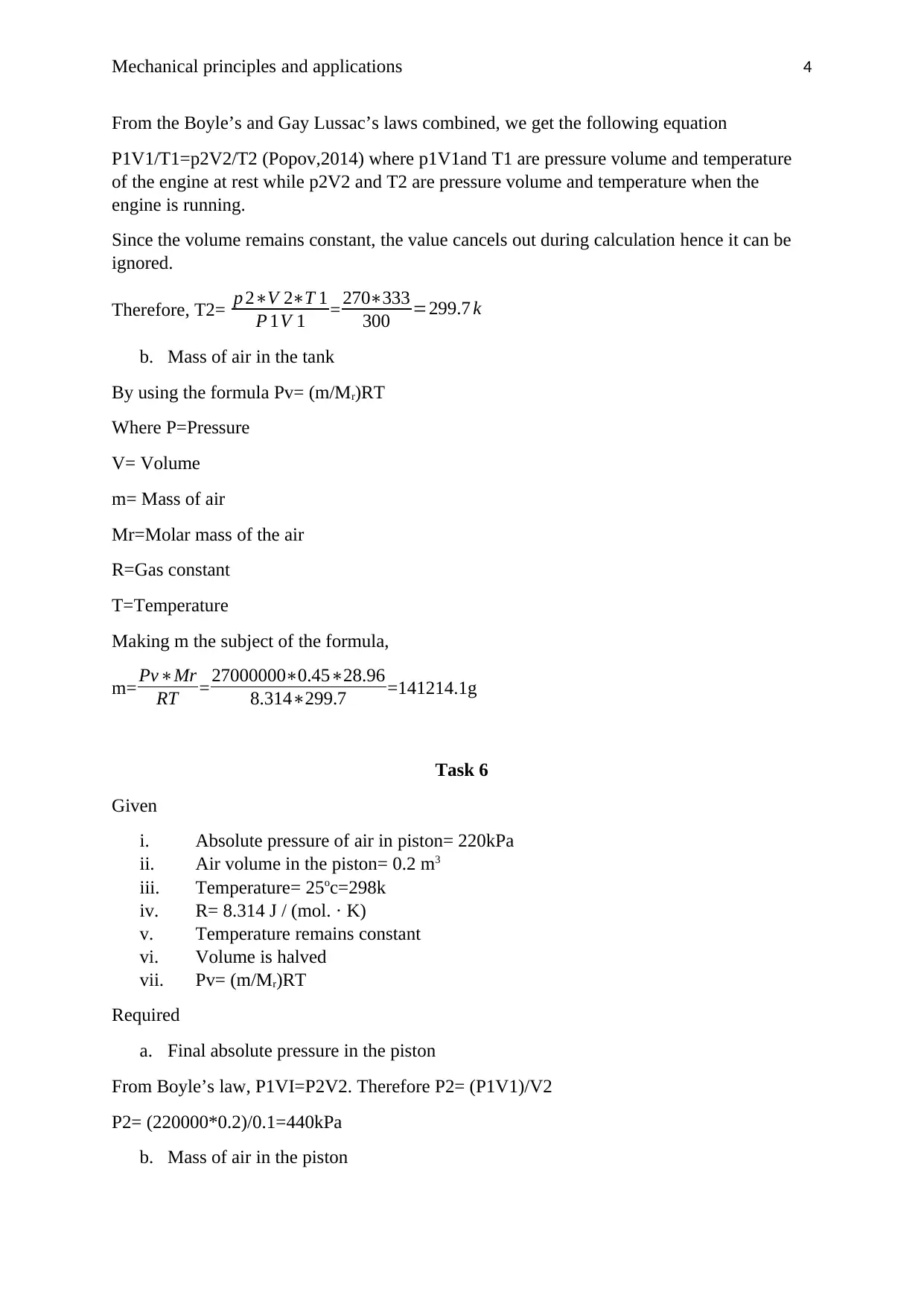
Mechanical principles and applications 4
From the Boyle’s and Gay Lussac’s laws combined, we get the following equation
P1V1/T1=p2V2/T2 (Popov,2014) where p1V1and T1 are pressure volume and temperature
of the engine at rest while p2V2 and T2 are pressure volume and temperature when the
engine is running.
Since the volume remains constant, the value cancels out during calculation hence it can be
ignored.
Therefore, T2= p 2∗V 2∗T 1
P 1V 1 = 270∗333
300 =299.7 k
b. Mass of air in the tank
By using the formula Pv= (m/Mr)RT
Where P=Pressure
V= Volume
m= Mass of air
Mr=Molar mass of the air
R=Gas constant
T=Temperature
Making m the subject of the formula,
m= Pv∗Mr
RT = 27000000∗0.45∗28.96
8.314∗299.7 =141214.1g
Task 6
Given
i. Absolute pressure of air in piston= 220kPa
ii. Air volume in the piston= 0.2 m3
iii. Temperature= 25oc=298k
iv. R= 8.314 J / (mol. · K)
v. Temperature remains constant
vi. Volume is halved
vii. Pv= (m/Mr)RT
Required
a. Final absolute pressure in the piston
From Boyle’s law, P1VI=P2V2. Therefore P2= (P1V1)/V2
P2= (220000*0.2)/0.1=440kPa
b. Mass of air in the piston
From the Boyle’s and Gay Lussac’s laws combined, we get the following equation
P1V1/T1=p2V2/T2 (Popov,2014) where p1V1and T1 are pressure volume and temperature
of the engine at rest while p2V2 and T2 are pressure volume and temperature when the
engine is running.
Since the volume remains constant, the value cancels out during calculation hence it can be
ignored.
Therefore, T2= p 2∗V 2∗T 1
P 1V 1 = 270∗333
300 =299.7 k
b. Mass of air in the tank
By using the formula Pv= (m/Mr)RT
Where P=Pressure
V= Volume
m= Mass of air
Mr=Molar mass of the air
R=Gas constant
T=Temperature
Making m the subject of the formula,
m= Pv∗Mr
RT = 27000000∗0.45∗28.96
8.314∗299.7 =141214.1g
Task 6
Given
i. Absolute pressure of air in piston= 220kPa
ii. Air volume in the piston= 0.2 m3
iii. Temperature= 25oc=298k
iv. R= 8.314 J / (mol. · K)
v. Temperature remains constant
vi. Volume is halved
vii. Pv= (m/Mr)RT
Required
a. Final absolute pressure in the piston
From Boyle’s law, P1VI=P2V2. Therefore P2= (P1V1)/V2
P2= (220000*0.2)/0.1=440kPa
b. Mass of air in the piston
Paraphrase This Document
Need a fresh take? Get an instant paraphrase of this document with our AI Paraphraser
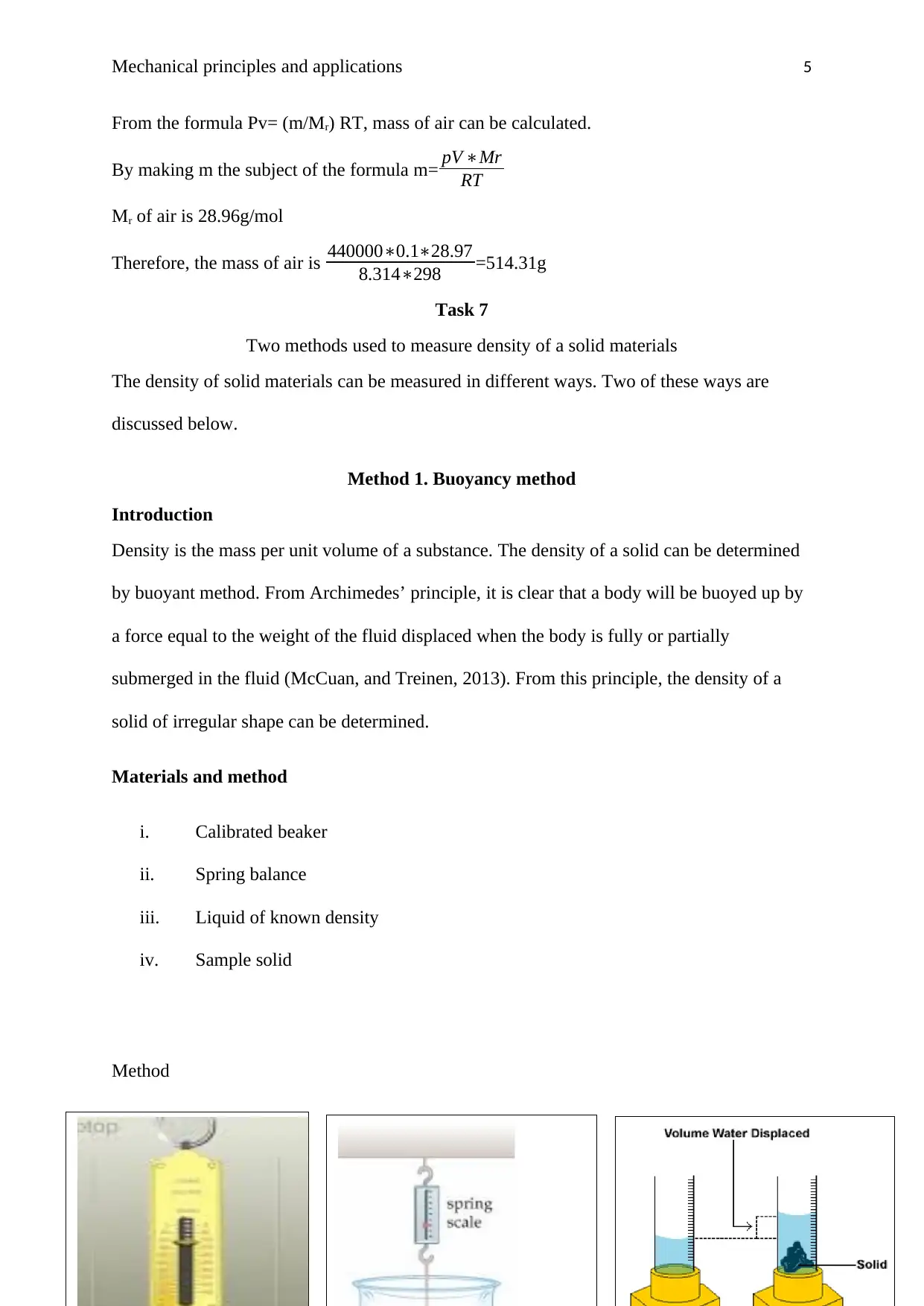
Mechanical principles and applications 5
From the formula Pv= (m/Mr) RT, mass of air can be calculated.
By making m the subject of the formula m= pV ∗Mr
RT
Mr of air is 28.96g/mol
Therefore, the mass of air is 440000∗0.1∗28.97
8.314∗298 =514.31g
Task 7
Two methods used to measure density of a solid materials
The density of solid materials can be measured in different ways. Two of these ways are
discussed below.
Method 1. Buoyancy method
Introduction
Density is the mass per unit volume of a substance. The density of a solid can be determined
by buoyant method. From Archimedes’ principle, it is clear that a body will be buoyed up by
a force equal to the weight of the fluid displaced when the body is fully or partially
submerged in the fluid (McCuan, and Treinen, 2013). From this principle, the density of a
solid of irregular shape can be determined.
Materials and method
i. Calibrated beaker
ii. Spring balance
iii. Liquid of known density
iv. Sample solid
Method
From the formula Pv= (m/Mr) RT, mass of air can be calculated.
By making m the subject of the formula m= pV ∗Mr
RT
Mr of air is 28.96g/mol
Therefore, the mass of air is 440000∗0.1∗28.97
8.314∗298 =514.31g
Task 7
Two methods used to measure density of a solid materials
The density of solid materials can be measured in different ways. Two of these ways are
discussed below.
Method 1. Buoyancy method
Introduction
Density is the mass per unit volume of a substance. The density of a solid can be determined
by buoyant method. From Archimedes’ principle, it is clear that a body will be buoyed up by
a force equal to the weight of the fluid displaced when the body is fully or partially
submerged in the fluid (McCuan, and Treinen, 2013). From this principle, the density of a
solid of irregular shape can be determined.
Materials and method
i. Calibrated beaker
ii. Spring balance
iii. Liquid of known density
iv. Sample solid
Method
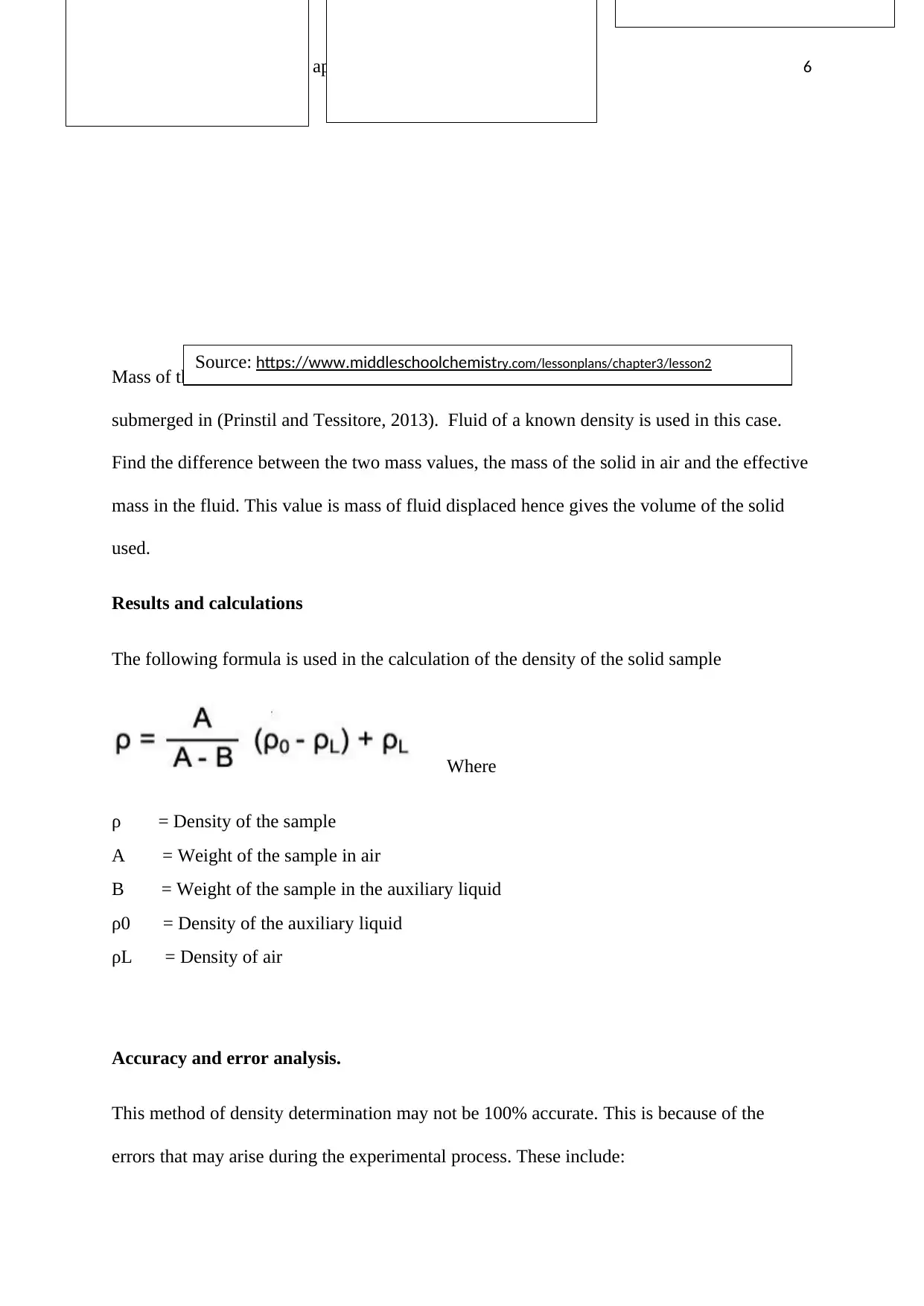
Mechanical principles and applications 6
Mass of the solid to be used is measured in air and then its effective mass in the fluid it is
submerged in (Prinstil and Tessitore, 2013). Fluid of a known density is used in this case.
Find the difference between the two mass values, the mass of the solid in air and the effective
mass in the fluid. This value is mass of fluid displaced hence gives the volume of the solid
used.
Results and calculations
The following formula is used in the calculation of the density of the solid sample
Where
ρ = Density of the sample
A = Weight of the sample in air
B = Weight of the sample in the auxiliary liquid
ρ0 = Density of the auxiliary liquid
ρL = Density of air
Accuracy and error analysis.
This method of density determination may not be 100% accurate. This is because of the
errors that may arise during the experimental process. These include:
Source: https://www.middleschoolchemistry.com/lessonplans/chapter3/lesson2
Mass of the solid to be used is measured in air and then its effective mass in the fluid it is
submerged in (Prinstil and Tessitore, 2013). Fluid of a known density is used in this case.
Find the difference between the two mass values, the mass of the solid in air and the effective
mass in the fluid. This value is mass of fluid displaced hence gives the volume of the solid
used.
Results and calculations
The following formula is used in the calculation of the density of the solid sample
Where
ρ = Density of the sample
A = Weight of the sample in air
B = Weight of the sample in the auxiliary liquid
ρ0 = Density of the auxiliary liquid
ρL = Density of air
Accuracy and error analysis.
This method of density determination may not be 100% accurate. This is because of the
errors that may arise during the experimental process. These include:
Source: https://www.middleschoolchemistry.com/lessonplans/chapter3/lesson2
⊘ This is a preview!⊘
Do you want full access?
Subscribe today to unlock all pages.

Trusted by 1+ million students worldwide
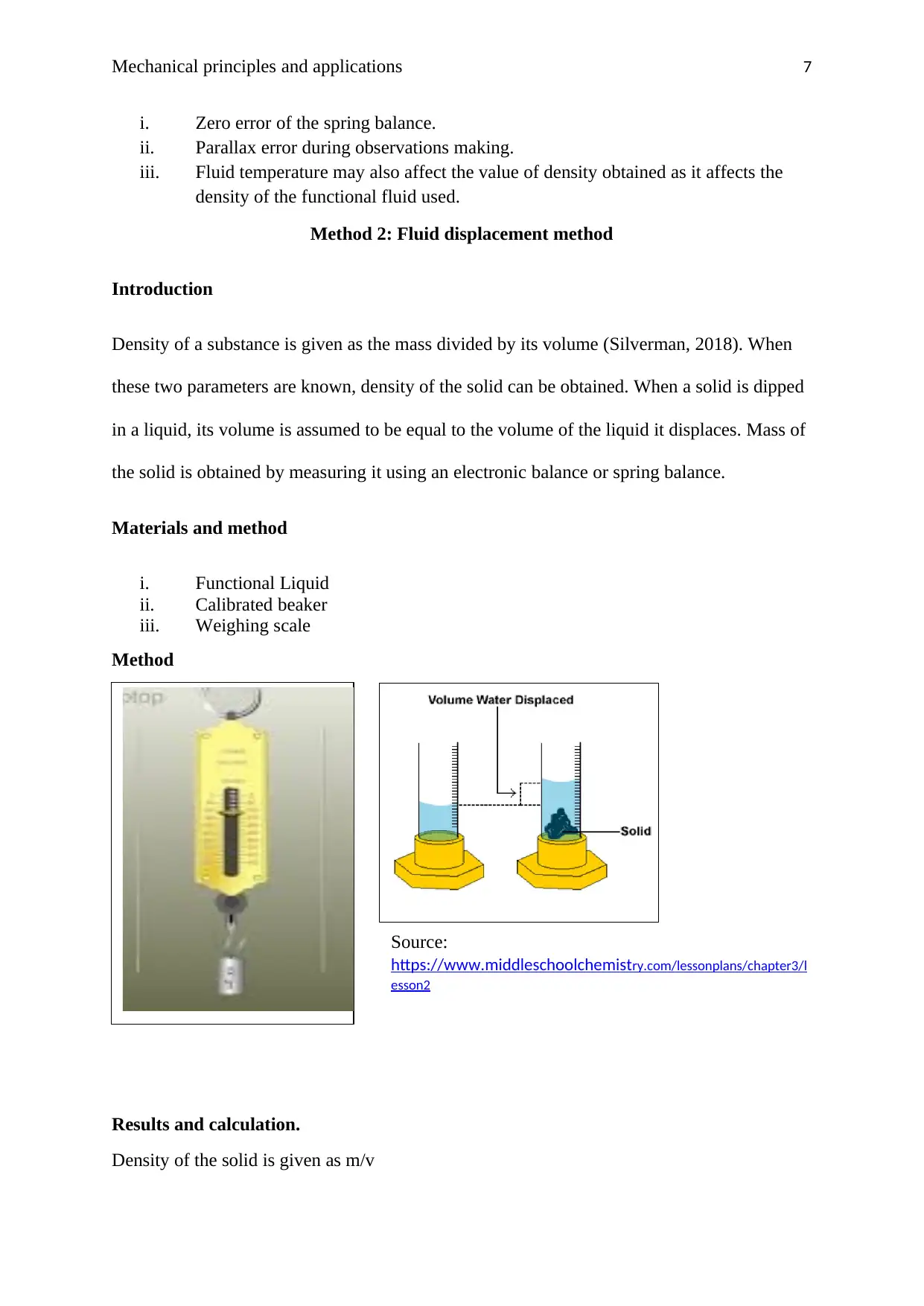
Mechanical principles and applications 7
i. Zero error of the spring balance.
ii. Parallax error during observations making.
iii. Fluid temperature may also affect the value of density obtained as it affects the
density of the functional fluid used.
Method 2: Fluid displacement method
Introduction
Density of a substance is given as the mass divided by its volume (Silverman, 2018). When
these two parameters are known, density of the solid can be obtained. When a solid is dipped
in a liquid, its volume is assumed to be equal to the volume of the liquid it displaces. Mass of
the solid is obtained by measuring it using an electronic balance or spring balance.
Materials and method
i. Functional Liquid
ii. Calibrated beaker
iii. Weighing scale
Method
Source:
https://www.middleschoolchemistry.com/lessonplans/chapter3/l
esson2
Results and calculation.
Density of the solid is given as m/v
i. Zero error of the spring balance.
ii. Parallax error during observations making.
iii. Fluid temperature may also affect the value of density obtained as it affects the
density of the functional fluid used.
Method 2: Fluid displacement method
Introduction
Density of a substance is given as the mass divided by its volume (Silverman, 2018). When
these two parameters are known, density of the solid can be obtained. When a solid is dipped
in a liquid, its volume is assumed to be equal to the volume of the liquid it displaces. Mass of
the solid is obtained by measuring it using an electronic balance or spring balance.
Materials and method
i. Functional Liquid
ii. Calibrated beaker
iii. Weighing scale
Method
Source:
https://www.middleschoolchemistry.com/lessonplans/chapter3/l
esson2
Results and calculation.
Density of the solid is given as m/v
Paraphrase This Document
Need a fresh take? Get an instant paraphrase of this document with our AI Paraphraser
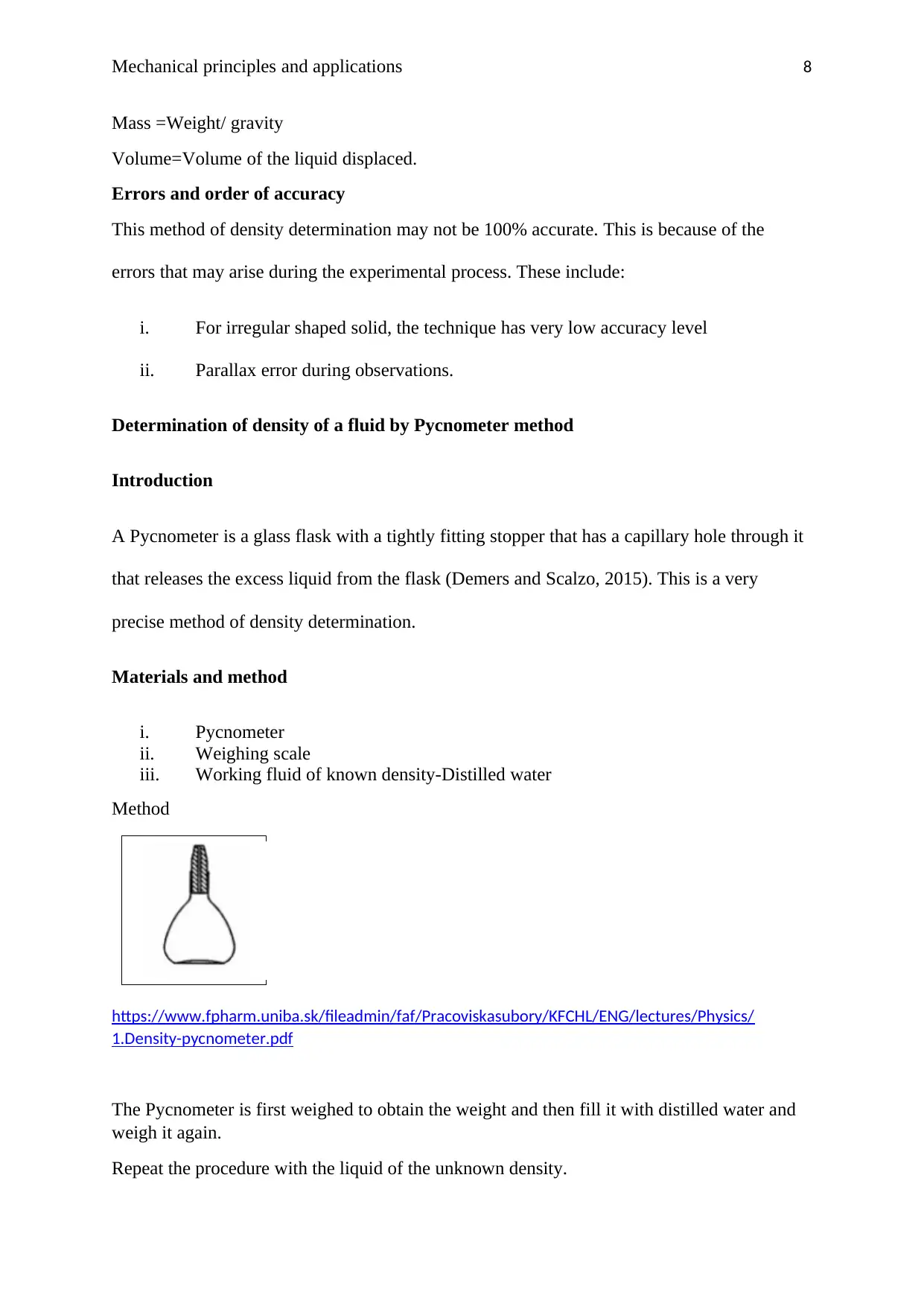
Mechanical principles and applications 8
Mass =Weight/ gravity
Volume=Volume of the liquid displaced.
Errors and order of accuracy
This method of density determination may not be 100% accurate. This is because of the
errors that may arise during the experimental process. These include:
i. For irregular shaped solid, the technique has very low accuracy level
ii. Parallax error during observations.
Determination of density of a fluid by Pycnometer method
Introduction
A Pycnometer is a glass flask with a tightly fitting stopper that has a capillary hole through it
that releases the excess liquid from the flask (Demers and Scalzo, 2015). This is a very
precise method of density determination.
Materials and method
i. Pycnometer
ii. Weighing scale
iii. Working fluid of known density-Distilled water
Method
https://www.fpharm.uniba.sk/fileadmin/faf/Pracoviskasubory/KFCHL/ENG/lectures/Physics/
1.Density-pycnometer.pdf
The Pycnometer is first weighed to obtain the weight and then fill it with distilled water and
weigh it again.
Repeat the procedure with the liquid of the unknown density.
Mass =Weight/ gravity
Volume=Volume of the liquid displaced.
Errors and order of accuracy
This method of density determination may not be 100% accurate. This is because of the
errors that may arise during the experimental process. These include:
i. For irregular shaped solid, the technique has very low accuracy level
ii. Parallax error during observations.
Determination of density of a fluid by Pycnometer method
Introduction
A Pycnometer is a glass flask with a tightly fitting stopper that has a capillary hole through it
that releases the excess liquid from the flask (Demers and Scalzo, 2015). This is a very
precise method of density determination.
Materials and method
i. Pycnometer
ii. Weighing scale
iii. Working fluid of known density-Distilled water
Method
https://www.fpharm.uniba.sk/fileadmin/faf/Pracoviskasubory/KFCHL/ENG/lectures/Physics/
1.Density-pycnometer.pdf
The Pycnometer is first weighed to obtain the weight and then fill it with distilled water and
weigh it again.
Repeat the procedure with the liquid of the unknown density.

Mechanical principles and applications 9
Results and calculation.
The following formula is used in the calculation of density.
Where l=Density of the test fluid
ml=Weight of the test fluid
mH20=Mass of the distilled water
H20=Density of the distilled water
Errors and order of accuracy
This method of density determination may not be 100% accurate. This is because of the
errors that may arise during the experimental process. These include:
i. Temperature change of the functional fluid
ii. Zero error of the weighing scale.
Results and calculation.
The following formula is used in the calculation of density.
Where l=Density of the test fluid
ml=Weight of the test fluid
mH20=Mass of the distilled water
H20=Density of the distilled water
Errors and order of accuracy
This method of density determination may not be 100% accurate. This is because of the
errors that may arise during the experimental process. These include:
i. Temperature change of the functional fluid
ii. Zero error of the weighing scale.
⊘ This is a preview!⊘
Do you want full access?
Subscribe today to unlock all pages.

Trusted by 1+ million students worldwide
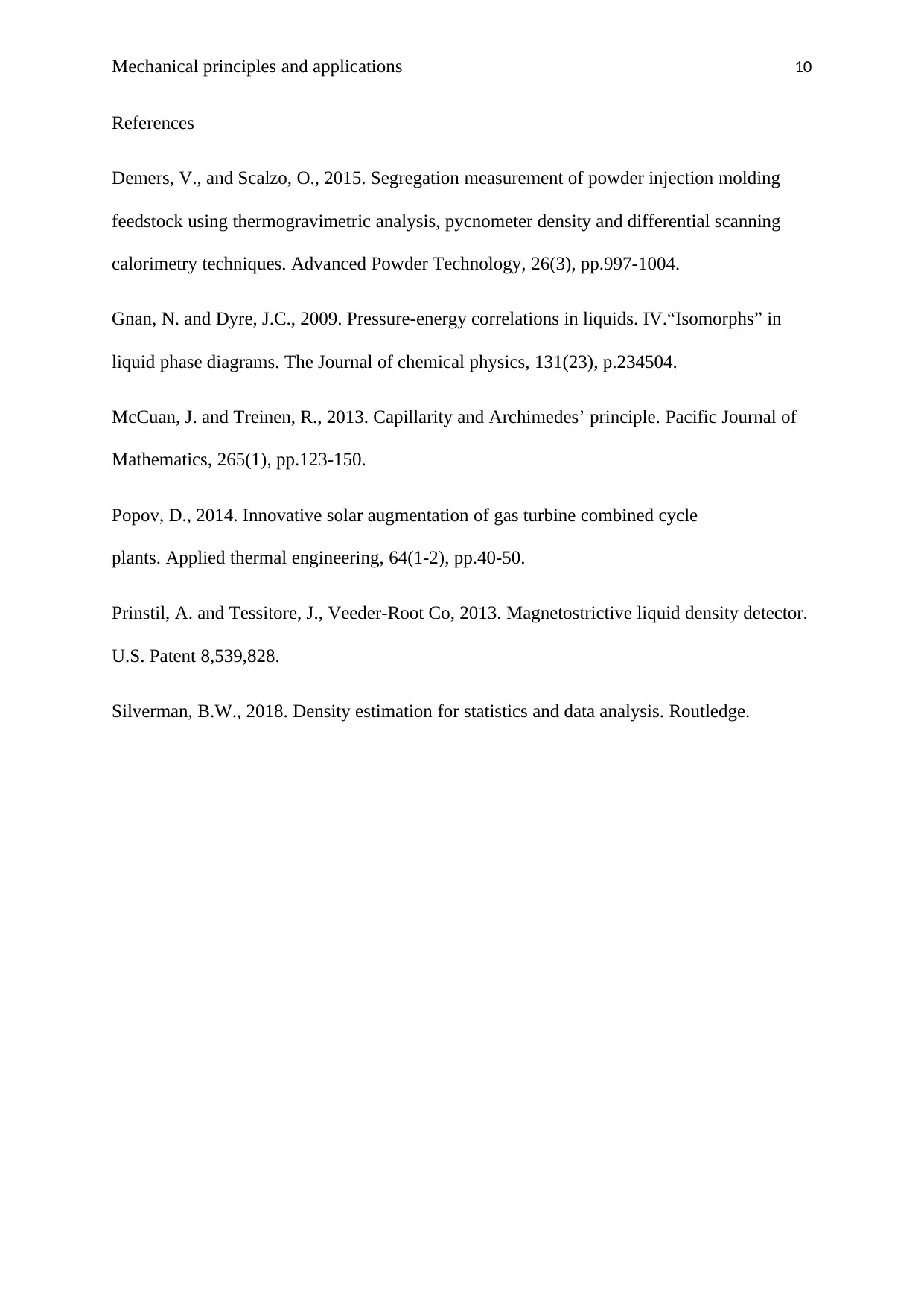
Mechanical principles and applications 10
References
Demers, V., and Scalzo, O., 2015. Segregation measurement of powder injection molding
feedstock using thermogravimetric analysis, pycnometer density and differential scanning
calorimetry techniques. Advanced Powder Technology, 26(3), pp.997-1004.
Gnan, N. and Dyre, J.C., 2009. Pressure-energy correlations in liquids. IV.“Isomorphs” in
liquid phase diagrams. The Journal of chemical physics, 131(23), p.234504.
McCuan, J. and Treinen, R., 2013. Capillarity and Archimedes’ principle. Pacific Journal of
Mathematics, 265(1), pp.123-150.
Popov, D., 2014. Innovative solar augmentation of gas turbine combined cycle
plants. Applied thermal engineering, 64(1-2), pp.40-50.
Prinstil, A. and Tessitore, J., Veeder-Root Co, 2013. Magnetostrictive liquid density detector.
U.S. Patent 8,539,828.
Silverman, B.W., 2018. Density estimation for statistics and data analysis. Routledge.
References
Demers, V., and Scalzo, O., 2015. Segregation measurement of powder injection molding
feedstock using thermogravimetric analysis, pycnometer density and differential scanning
calorimetry techniques. Advanced Powder Technology, 26(3), pp.997-1004.
Gnan, N. and Dyre, J.C., 2009. Pressure-energy correlations in liquids. IV.“Isomorphs” in
liquid phase diagrams. The Journal of chemical physics, 131(23), p.234504.
McCuan, J. and Treinen, R., 2013. Capillarity and Archimedes’ principle. Pacific Journal of
Mathematics, 265(1), pp.123-150.
Popov, D., 2014. Innovative solar augmentation of gas turbine combined cycle
plants. Applied thermal engineering, 64(1-2), pp.40-50.
Prinstil, A. and Tessitore, J., Veeder-Root Co, 2013. Magnetostrictive liquid density detector.
U.S. Patent 8,539,828.
Silverman, B.W., 2018. Density estimation for statistics and data analysis. Routledge.
1 out of 10
Related Documents
Your All-in-One AI-Powered Toolkit for Academic Success.
+13062052269
info@desklib.com
Available 24*7 on WhatsApp / Email
![[object Object]](/_next/static/media/star-bottom.7253800d.svg)
Unlock your academic potential
Copyright © 2020–2025 A2Z Services. All Rights Reserved. Developed and managed by ZUCOL.



